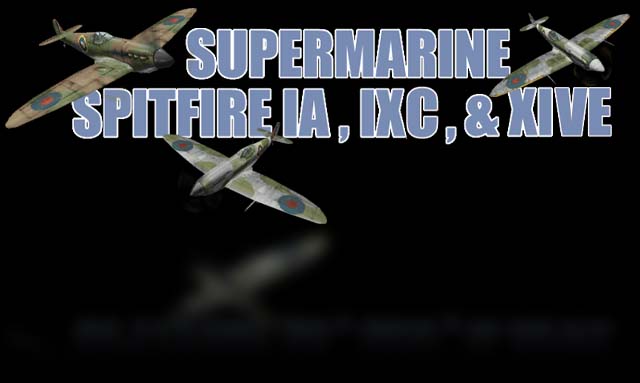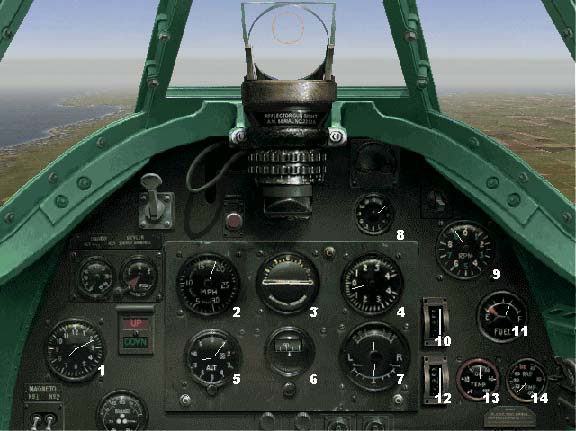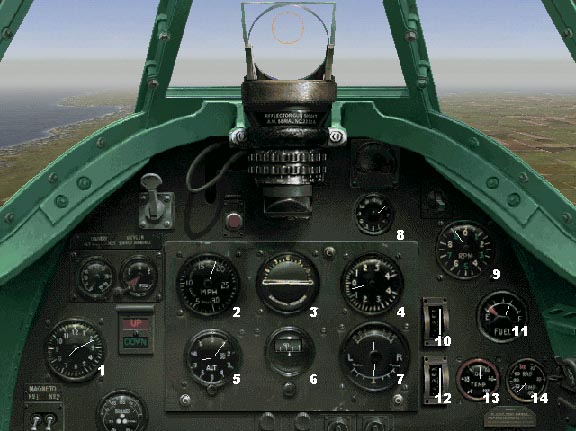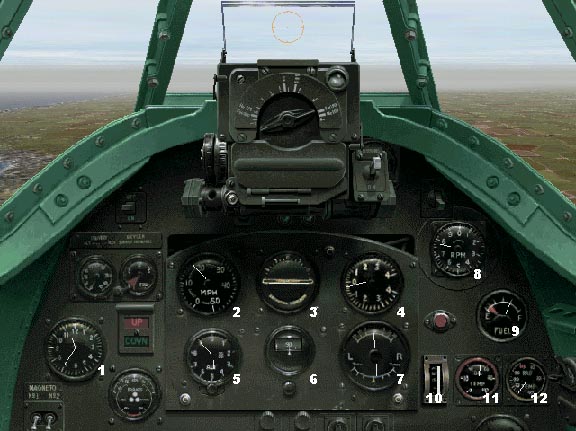
European Air War

Supermarine Spitfire
The Spitfire was conceived about the time that the importance of speed and climb rate was being discovered. Subsequently, the early Spitfires were rather slow with poor climb rates, but (being very light weight) possessed excellent turn performance.
The Spitfire Ia and the early Bf109 are well-matched, with the 109 being slightly faster in level flight and accelerating quicker in a dive. At slow speeds, however, the Spitfire is much more maneuverable and rolls faster than the 109. The Spitfire Ia suffers at high altitude, however, with the Bf109E clearly superior above 20,000 feet. The Spitfire Ia is under armed; its light punch can't guarantee lethality against targets with self-sealing fuel tanks (such as the He111 bomber). Further, the Spitfire Ia's carburated engine will cut out under negative G, something the fuel-injected Bf109 doesn't have to worry about. The Spitfire Ia must watch out for high-speed bandits diving from above, and generally needs to sucker the opponent into a low-speed turning fight.
Turn performance is good, but being slower meant that the enemy could generally dictate the terms of the fight, disengaging at will. Subsequently, later Spitfires added emphasis on speed. The Spitfire IX is generally 20% faster at all altitudes, accelerates better, and climbs faster than earlier variants. It can still dominate the low-speed turning fight against a 109, but also has the option of diving away and escaping a battle. Lastly, the Spitfire IX packs more punch, carrying two 20mm cannons and four .303cal machine guns.
Faster German planes, like the Fw190, again called for a faster Spitfire. The Spitfire XIV, weighing some 8,400 pounds compared to the Spitfire Ia's 5,700, is substantially faster than the IX, performing better at all altitudes. The XIV can meet any Luftwaffe fighter on equal terms with the exception of the significantly-faster Me262 jet.
Supermarine Spitfire IA

1. Clock
2. Airspeed Indicator
3. Artificial Horizon
4. Rate of Climb Indicator
5. Altimeter
6. Gyro Compass
7. Turn and Bank Indicator
8. Manifold Pressure
9. Tachometer
10. Fuel Pressure Gauge
11. Fuel Gauge
12. Oil Pressure Gauge
13. Engine Temperature Gauge
14. Coolant Temperature Gauge
Specs
- Wingspan: 36 ft. 10 in.
- Length: 29 ft. 11 in.
- Height: 11 ft. 5 in.
- Wing Area: 242 sq. ft.
- Engine: Rolls-Royce Merlin II rated at 1,030 hp.
- Fuel: 102 gal. internal
- Loaded Weight: 5,784 lb.
- Wing Loading: 24 lb./sq. ft.
- Maximum Speed: 355 mph.
- Service Ceiling: 34,000 ft.
- Rate of Climb: 2,500 ft./min
- Combat Radius: 190 miles
- Armaments: 8 x .303 cal. Browning machine guns
- Ammunition: 350 rds/gun (.303cal)
Supermarine Spitfire IXC

1. Clock
2. Airspeed Indicator
3. Artificial Horizon
4. Rate of Climb Indicator
5. Altimeter
6. Gyro Compass
7. Turn and Bank Indicator
8. Manifold Pressure
9. Tachometer
10. Fuel Pressure Gauge
11. Fuel Gauge
12. Oil Pressure Gauge
13. Engine Temperature Gauge
14. Coolant Temperature Gauge
Specs
- Wingspan: 36 ft. 10 in.
- Length: 30 ft. 6 in.
- Height: 12 ft. 7 in.
- Wing Area: 242 sq. ft.
- Engine: Rolls-Royce Merlin 61 rated at 1,565 hp.
- Fuel: 102 gal. internal
- Loaded Weight: 7,500 lb.
- Wing Loading: 31 lb./sq. ft.
- Maximum Speed: 408 mph.
- Service Ceiling: 44,000 ft.
- Rate of Climb: 4,150 ft./min
- Combat Radius: 145 miles
- Armaments: 2 x 20mm Hispano cannons, 4 x .303 cal. Browning machine guns
- Ammunition: 120 rds/gun (20mm), 350 rds/gun (.303cal)
Supermarine Spitfire XIVE

1. Clock
2. Airspeed Indicator
3. Artificial Horizon
4. Rate of Climb Indicator
5. Altimeter
6. Gyro Compass
7. Turn and Bank Indicator
8. Tachometer
9. Fuel Gauge
10. Oil Pressure Gauge
11. Engine Temperature Gauge
12. Coolant Temperature Gauge
Specs
- Wingspan: 36 ft. 10 in.
- Length: 32 ft. 8 in.
- Height: 12 ft. 8 in.
- Wing Area: 242 sq. ft.
- Engine: Rolls-Royce Griffon 65 rated at 2,050 hp.
- Fuel: 138 gal. internal
- Loaded Weight: 8,500 lb.
- Wing Loading: 35 lb./sq. ft.
- Maximum Speed: 448 mph.
- Service Ceiling: 44,500 ft.
- Rate of Climb: 4,580 ft./min
- Combat Radius: 150 miles
- Armaments: 2 x 20mm Hispano cannons, 2 x .50 cal. Browning machine guns
- Ammunition: 120 rds/gun (20mm), 250 rds/gun (.50cal)
Notes: The Spitfire I suffered from a carburetor problem which caused the engine to cut out if the pilot performed an inverted maneuver like a Split-S. The Spitfire Ia can only be flown clean. The Spitfire IX and XIV should be flown in a clean configuration for all mission types except Strike, where each should be equipped with two 500 lb. bombs.
This material was included in the original 1998 release of European Air War by Microprose.
